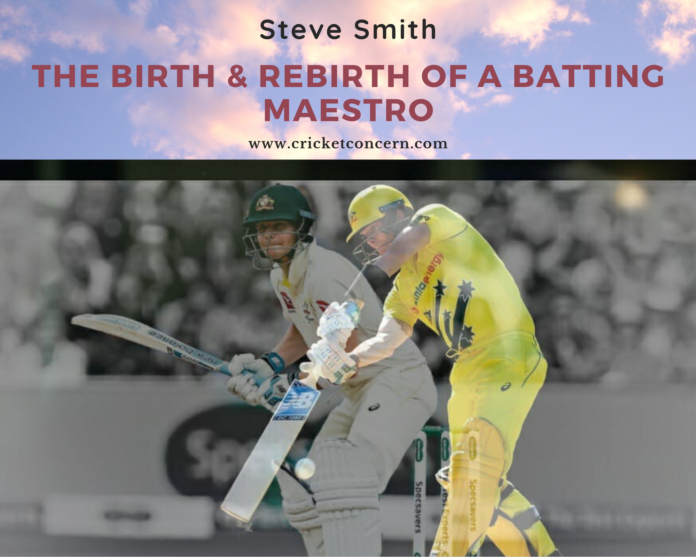The first impression:
If I had to tell my kids in the future about the cricketing master class featuring the ups and downs of their career, Steven Smith will be the first one I’ll be introducing them with.
His career redemption is a tactful story for the ages. Having introduced himself as a young leg spinner who can bat a bit too in the end, he has profoundly changed his attributes to be one of the best in batsmanship.
I can remember myself watching him play for the first time back on Oct 23, 2009, when New South Wales (his team) faced Trinidad and Tobago in the Final of champions league T20 at Hyderabad.
Brett lee used to be the one, whom I followed since childhood and even copied his action while bowling. So, it was obvious to watch the full match and I did so.
I feel amazed to see a lower-order batsman, Steven Smith banging important 26 balls 33 runs coming at the toughest of time, and that day Brett Lee too banged 31 balls 48 runs.
Later on the second innings, Steven picked up two wickets within the power play and created an eventful impact upon me and I have been following him since that night. He completed his 4 over quota with 2-32.
Steven Smith was born in Sydney, New South Wales on June 2, 1989, from Peter Smith, a Chemist, and English mother, Gilliam smith. He dropped out of college at the age of 17 while studying 10th standard due to a lack of interest in studies and more affection towards cricket.
He was well focused on achieving the dream of representing his country in international cricket. With the support of his parents, he started devoting his time to cricket. However, his father always wanted him to be the best batsman in the world, but he had relatively lesser skill as far as the batting was concerned.
At the age of 6, he was selected for the team of U-8 and started training with his father until 16 years old. Then, he joined seven oaks Vine Cricket Club in England at the age of 17. His bowling skills were truly recognized and he got a chance to play a domestic cricket match against Western Australia in which he scored 33 runs.
The charm of young leg-spin maestro rose to another level when he was compared with the legend, Shane Warne, owing to this brilliant rip off the ball and similar run-up.
The popular league in Australia which is known as the KFC Big Bash league nowadays used to be held as a competition named KFC Big bash Competition initially. In 2008, he was the highest wicket-taker in the competition with 9 wickets for his team.
As cricketing concerned experts started to take a closer look over his talent, he was still confused about which country he shall represent in the future. He had both the citizenship of England and Australia.
He discussed a few times with his parents and the officials from the club and came out with the decision to play for Australia now on.
He was bullied for his shy nature and relatively short height as compared with other teammates. But, the kind of romance that he used to show with the ball in the middle left everyone amazed and shut their mouth so early.
He continued growing as a full-time leg spinner and a batsman who can hold a bit of nerve in the middle and score runs freely. He was called up for the national team to play the only T20 match against Pakistan in 2010 and made his debut on 5 February 2010 where he was impressed with the bowling as he picked 2 for 34 runs and scored 8 runs with the bat.
On the same month, he made his ODI debut against West Indies on 19 February, 2010, where he picked 2 wickets. The best Test batsman in the world made his test debut on July 13, 2010 against Pakistan.
He did not get a chance to bowl in the first innings and when he got a chance in the second innings; he bagged 3 wickets and was impressive in the fielding too.
The best of his batting came in the 2nd test of the series when he scored his maiden half-century scoring 77 runs in a crucial time. He went wicketless in the match though bowling 10 overs in both innings giving away 31 runs with 2 maidens.
His selection during the Ashes series 2010-2011 drew a lot of contempt and after losing the series, his career was put down to the shade when he was dropped from all formats of the game. He went wicketless in the matches he played and scored 159 runs with the bat in six innings.
Experts from the cricket field meanwhile, admired his batting attribute more than his bowling and this made Smith feel courageous enough to try and figure that out. He started working more consciously in his batting attribute.
A batsmen’s birth:
After more than a year of hard work and performances in the domestic cricket, his patience paid off when he was called up to the squad during the Ashes 2013. However, this time he was renowned as a batsman rather than an all-rounder.

He presented the new and upgraded version of his batsmanship, mentality, and intent which was eventually backed and supported by the selectors and he was on the verge of a resurgence. He managed to score a total of 345 runs in 10 innings with an average of 38.33 with a half-century and a maiden test century.
He has never looked back since then. He produced an important crisis knocks in the series against South Africa later in the year.
His continuous performance saw him achieve various milestones and his exploits saw him ranked number one in Tests during the year 2015 and has remained there since then, and also by a fairly good margin as well.
He proved himself right against any condition and bowlers when he especially performed in the test series against India’s brutal bowling attack. Despite his unorthodox stance and trigger movement across the stumps, he was never criticized since he performed well in every format.
Birth of a leader :
He was named Australia’s new vice-captain and following an injury to Michael Clarke, he was appointed stand-in skipper. He made his captaincy debut for Australia in the second test match against India at Gabba. He scored four consecutive centuries in the series and three as a skipper.
His performances in the World Cup 2015 were unbelievable where he smashed consecutive half-centuries in his 5 innings(one century against India) to become Australia’s highest run-scorer in the 2015 World Cup with 402 runs with an average of 67.00 in 8 matches.
The retirement of Michael Clarke from international cricket meant that Australia will see a young and energetic test captain, Mr. Steven Smith.
It seemed like things were perfect for Smith, runs kept coming especially in Tests. Meanwhile, his lack of consistency in white-ball cricket was a bit concern for the team. The Australian test team was performing so well in various regions of the world.
Australia topped the test team ranking in 2016 and raised its standard under Smith. But, things went a bit drastic as they dropped to 3rd spot in team test ranking in 2017 and 2018.
Dawn of a bright light:
It was Australia vs South Africa’s third test when an unexpected tragedy struck to Australian cricket and even to whole cricket when the on-field actions went out of limit from the Australian side.
Australia was found guilty of ball-tampering that was purely intentional as seen in the footages as Bancroft was captured rubbing the rough side of the ball with the sandpaper to enhance swing and drift.
This was an unusual sight that was captured and which when later investigated, Australian players were found guilty. It shook the whole cricket world as the scandal gets on top of social media.
Both Smith and Bancroft admitted for the action and apologized to the press conference.
Also, Captain Smith and Vice-Captain Warner stood down from the duty for the rest of the match and wicketkeeper Tim Paine took over as interim captain for the rest of the Test match.
Smith was sanctioned with a one-match ban by ICC, but the decision was taken by the Australian Cricket Board even shook the world even more. They imposed the ban over a year to the Skipper along with his deputy and youngster Bancroft with 9 months ban.
Smith arrived in Sydney on 29 March. In a press conference at Sydney Airport, a tearful Smith started by saying that he had nothing to add to Cricket Australia’s report.
He said that as captain of the Australian cricket team, he took full responsibility (even though he did not devise the plan to change the condition of the ball or actually perform the act) and that he had made a serious error in judgment.
“It was a failure of leadership, my leadership.” As well as apologizing to his teammates, to fans of cricket all over the world and to all Australians who are disappointed and angry”, he specifically referred to the effect that the incident had on his parents.
He added, “I know I will regret this for the rest of my life. I’m absolutely gutted. I hope in time I can earn back respect and forgiveness.
The Re-birth:
Having endured a tough one-year ban, Smith returned to competitive cricket in March 2019 through IPL. Despite seeming a bit shaky, his class was evident and it wasn’t surprising when he walked straight back into Australia’s World Cup 2019 squad. After missing the 2018–19 season, Smith signed the national for season 2019–20.
Smith returned to international cricket against Afghanistan in the opening match of the World Cup 2019 and scored 18 runs from 27 balls. He scored 379 runs at an average of 37.90, including four fifties in the 2019 ICC World Cup.
In July 2019, he was named in Australia’s squad for the 2019 Ashes series in England. In the first Test at Edgbaston, Smith scored centuries in both innings. In the first innings of the second Test, his innings was interrupted on 80, when he was hit by a 148.7 km/h ball on the left side of his neck, under the ear from Jofra Archer.
He later returned to complete his innings after passing the concussion tests and was out for 92. Smith reclaimed the number one position in the Test batting ranking on 3 September 2019.
In the first innings of the fourth Test at Old Trafford Smith scored his third double-century in Test matches and third century in the series and became the first batsman to score 500 or more runs in three successive Ashes series.
Smith registered his tenth consecutive Ashes fifty-plus score in the first innings of the fifth Test. He finished the series with 774 runs in just 7 innings with an average of 110.57, by far the most on either side, winning the man of the series award in Ashes 2019.
He stood against all the odds in the whole series and with delight became the sole difference between the two sides in the whole series which drew level on 2-2 and the Australians retain the urn.
Returning to international cricket in that fashion especially after a year ban, was remarkable for him, his fans, and to the Australian cricket board, since Australia topped the test ranking, courtesy of the urn retained by Australia in England.
Once Vince Lombardi quoted, “It’s not when you get knocked down; it’s whether you get up.” This statement exactly fits the kind of return he has shown in international cricket after being let down by the board, fans, and public.
I wish his form in all formats remains the same and his resurgence could be heard through the years. A star was born who got strangled in between, witnessed the ups and downs of the career, and has again come back with immense strength and intent to rule the red-ball cricket, especially.
Not everyone gets that opportunity to express themselves through their ability and not everyone can be born and reborn again in Cricket. But, he’s a master class: truly a legend.







